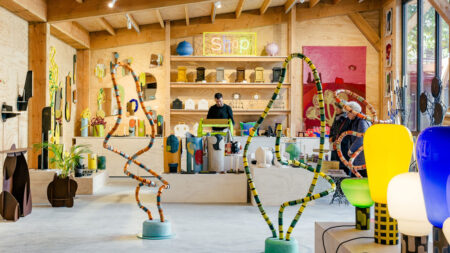For years, Finnish wooden furniture brand Nikari has been designing and manufacturing products that are durable and ecological. Despite being produced in small series, each piece designed and crafted by Nikari’s experienced designers and wood makers is unique and pays homage to finest Nordic craftsmanship.
Under the leadership of its CEO, Johanna Vuorio, the Finnish wood design studio has further strengthened its commitment to sustainable design and traditional craftsmanship. We touch base with Nikari CEO to learn more about the company goals, sustainable choice, and finding a crucial balance between design and nature while bringing out the best of wood in contemporary design.
Homecrux (HC): Thank you for taking time to talk to Homecrux. Please tell us how did the journey of Nikari begin, and how did you get associated with it?
Johanna Vuorio (JV): Nikari was founded in 1967. So we are 57 years old at the moment. It was founded by Kari Virtanen. When he started, he was very well known in this area, and therefore the first customer who came to knock on his door was Alvar Aalto architect office. Years later, we had our second client, Kaj Franck. So these two gentlemen who represented the finest of Finnish architecture and modern design were not just our clients but initial mentors as well. We sometimes even call them the fathers of modern Finnish architecture and Modern Finnish Design, respectively. The collaboration led to Kari Virtanen learning more and more about design and modern ways of looking at it.

When the millennium changed, Kari also started to look for someone to continue the company. He was never really interested in running a big business and he and his business partner, Rudi Merz, thought that they would either like to stop the company or find someone to continue. And this is how I was originally contacted in 2007. And in 2009, after several discussions and hard core thinking on my part, I thought that I would have the courage to jump in and start as an entrepreneur.
So I started running Nikkari in 2009 and then I brought majority of the shares in 2010. My idea was to fulfil Kari’s beautiful dreams of passing traditional craftsmanship knowledge on to the next generation and trying my best in keeping the skill alive by training young cabinet makers, which we are very happy to say we still do.

Homecrux: How does Nikari incorporate sustainable practices into the design process and the products created?
JV: Sustainability is important for us. We use wood from certified forests only, where annual growth exceeds annual cut. Additionally, we have a lot of furniture, made of mono-material. We use wood that has worked as a carbon sink and will stay as a carbon sink even when turned into a piece of furniture. Furthermore, we are trying to recycle all the material that is left behind such as the finest wood chips and the scraps.
Homecrux: Designs at Nikari are known for their minimalist yet functional approach. What inspires your design and how do you ensure that form follows function in your work?
JV: The first inspiration is the material. Everything we design always starts with the beauty of the material and how to enhance the overall design. We work with the most ecological material in the world. But it doesn’t mean anything if the product gets broken really easily or if it’s so ugly that no one wants it. We need to look at the entity. We need to create beautiful designs. We need to create products that really last for a lifetime or longer. I’d say longer in our case.
Homecrux: Does Nikari has in-house designers or do you work with freelance designers who are contracted for a certain amount of time?
JV: We have our creative director Jenni Roininen, and Kari Virtanen, naturally. We see them as our in-house designers for sure. And then we have a great group of brilliant designers that we collaborate with. They come from all over the world. We share our idea about the material with these designers and its wonderful to see how beautifully they turn the briefs and give shape to the product. So, we are just trying to find the best ways to collaborate with different designers in order to find the end results in the design process that really underlines the beauty of the material.
Homecrux: Please tell us more about this holistic approach that you follow while scouring designers?
JV: We are always intrigued by talent. Sometimes we see someone at a student section at a fair and sometimes we bump upon designers that we really like. For instance, we exhibited Faneeri folding chair in Milan. It was designed by a young Swedish designer called Jonas Forsman. We had a pre-notion that we would never consider to have a folding chair at Nikari but this idea was just so perfect. It felt like we must make a product out of it.

HC: Has Woodnotes merged with Nikari or does it continue to be a separate entity?
JV: Nikari and Woodnotes continue to be different entities. Mikko Puotila, who founded Woodnotes is now the chairman of the board and he still works for Woodnotes. So, it’s a lovely collaboration between our two companies. Both the companies still engage in export, sales and a lot of marketing together. One aspect where we separate is the production. Woodnotes go in their own ways and Nikari has its own strategy. In a nutshell we are still separate companies. I just continue to be the CEO of both.

Homecrux: Being a woman entrepreneur, how big a challenge it is to run two design studios simultaneously?
JV: It’s passion and lifestyle. I love the products we are creating. So it’s very rewarding all the time. And it feels like we have two, wonderful teams. All the team members in both companies are professionals so it’s quite easy for me. It doesn’t feel like a double stress. It feels like a double blessing in a way. But, I’d say that naturally it’s time consuming and I travel quite a lot. So, I don’t have a similar day or two similar days ever. Whenever I get a chance, I go out and hike or walk in the forests.
Homecrux: Do you often travel for business as well? Did you attend Salone del Mobile this year or 3daysofdesign?
JV: Yes, we were there. We had our booth at Salone del Mobile and we had a wonderful place also at 3daysofdesign. I was in both of them and in between I was traveling a lot.
Homecrux: What products did you exhibit at these events?
JV: At Salone del Mobile, our new release was the Faneeri chair. We also launched Archetype Lounge chair by Jasper Morrison. We also unveiled three small pieces ‘Three Wooden Trees’ by Alfredo Heberli, the Swiss designer. The same products were also exhibited at 3daysofdesign. We exhibited the Frame Low table by John Pawson.



Homecrux: Having seen design and architecture industry from this close, what advice would you give to budding designers who are looking to establish their own design studios?
JV: My advice would be to stay humble. Even the best ones stay humble. Other thing I would recommend to budding designers is to learn to do the groundwork. Because the practical side is so different from how it looks from outside. So it’d be tremendously helpful for the designer to realize and understand what is being done in order to manufacture a new product, or what is required to do serial production. This would be very helpful, very educative, and also inspirational in a designer’s journey.
We thank Johanna Vuorio for taking time out of her busy schedule and being available for the interview with Homecrux!
Follow Homecrux on Google News!




